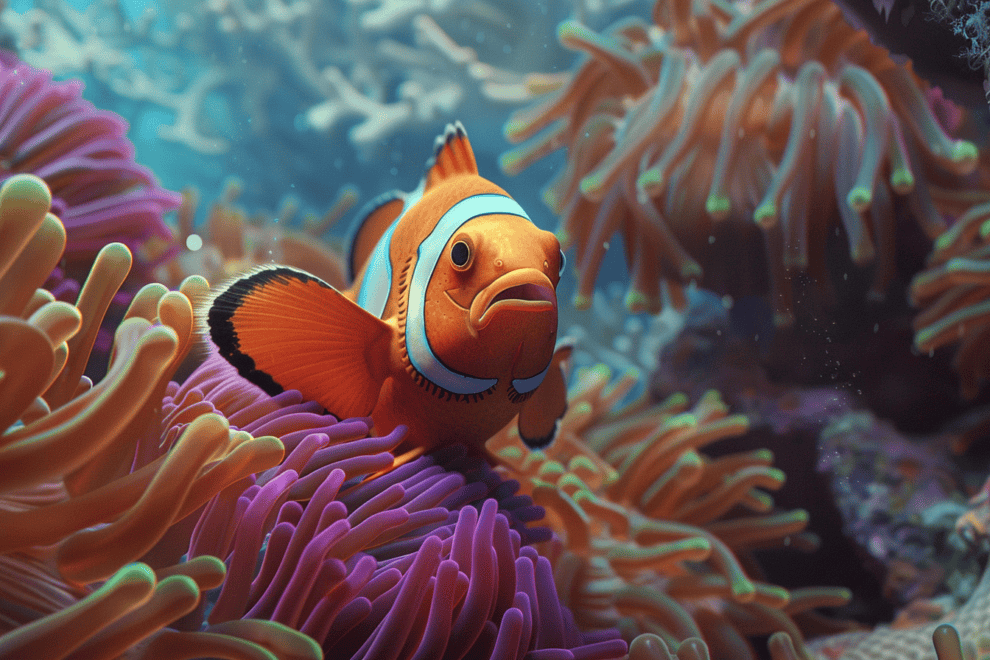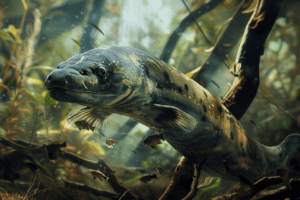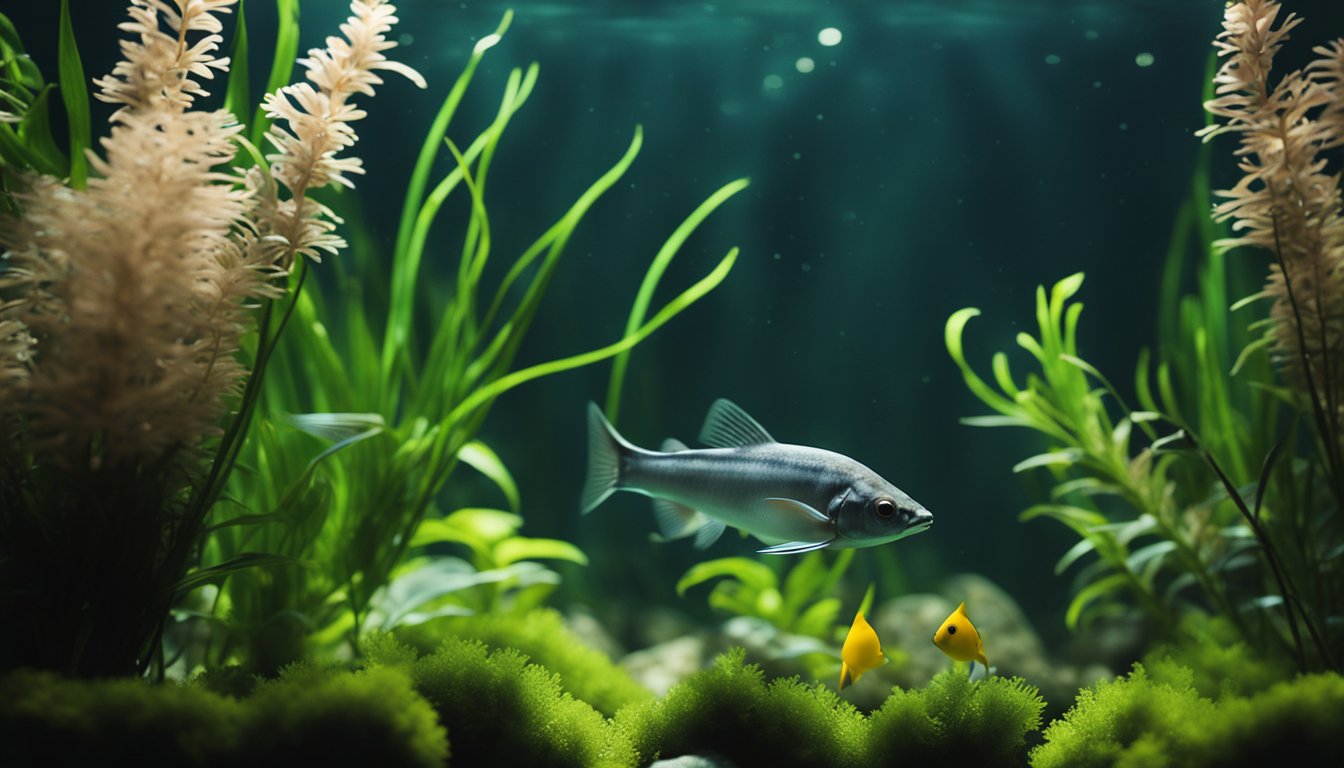Clownfish and sea anemones have amazing symbiotic relationship.
Clownfish find refuge among the anemone’s stinging tentacles, protected from predators by a special mucus that makes them immune to the sting.
In return, clownfish provide food scraps and keep the anemone clean, boosting its health and vigor. This partnership highlights the intricate balance of underwater ecosystems, where each fish sways gracefully, ensuring mutual survival.
The beauty of this relationship isn’t just in protection and nourishment, but in how these species co-evolved to maintain the delicate harmony of coral reefs.
The Symbiotic Relationship
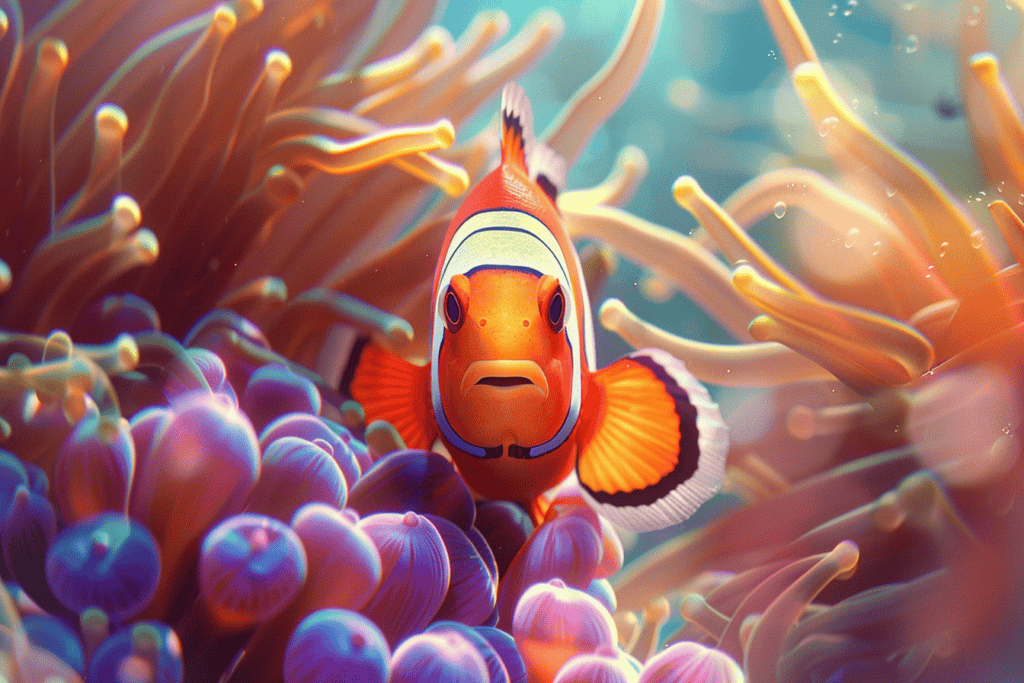
Within the vibrant world of coral reefs, the symbiotic relationship between clownfish and sea anemones stands out as a fascinating example of mutualism.
This mutualistic relationship is truly remarkable, as both species reap significant benefits from it.
The clownfish, with its bright colors, finds a safe haven among the stinging tentacles of the sea anemone. These tentacles, lethal to many marine creatures, provide a protective layer that shelters the clownfish from predators.
In return, the clownfish benefits the sea anemone by offering it food scraps and keeping it clean from debris. You’ll notice that the clownfish’s movements help increase water circulation around the sea anemone, which is essential for its respiration and nutrient uptake.
This symbiotic relationship is a brilliant example of nature’s balance, where both the clownfish and the sea anemone thrive together.
Clownfish Adaptations
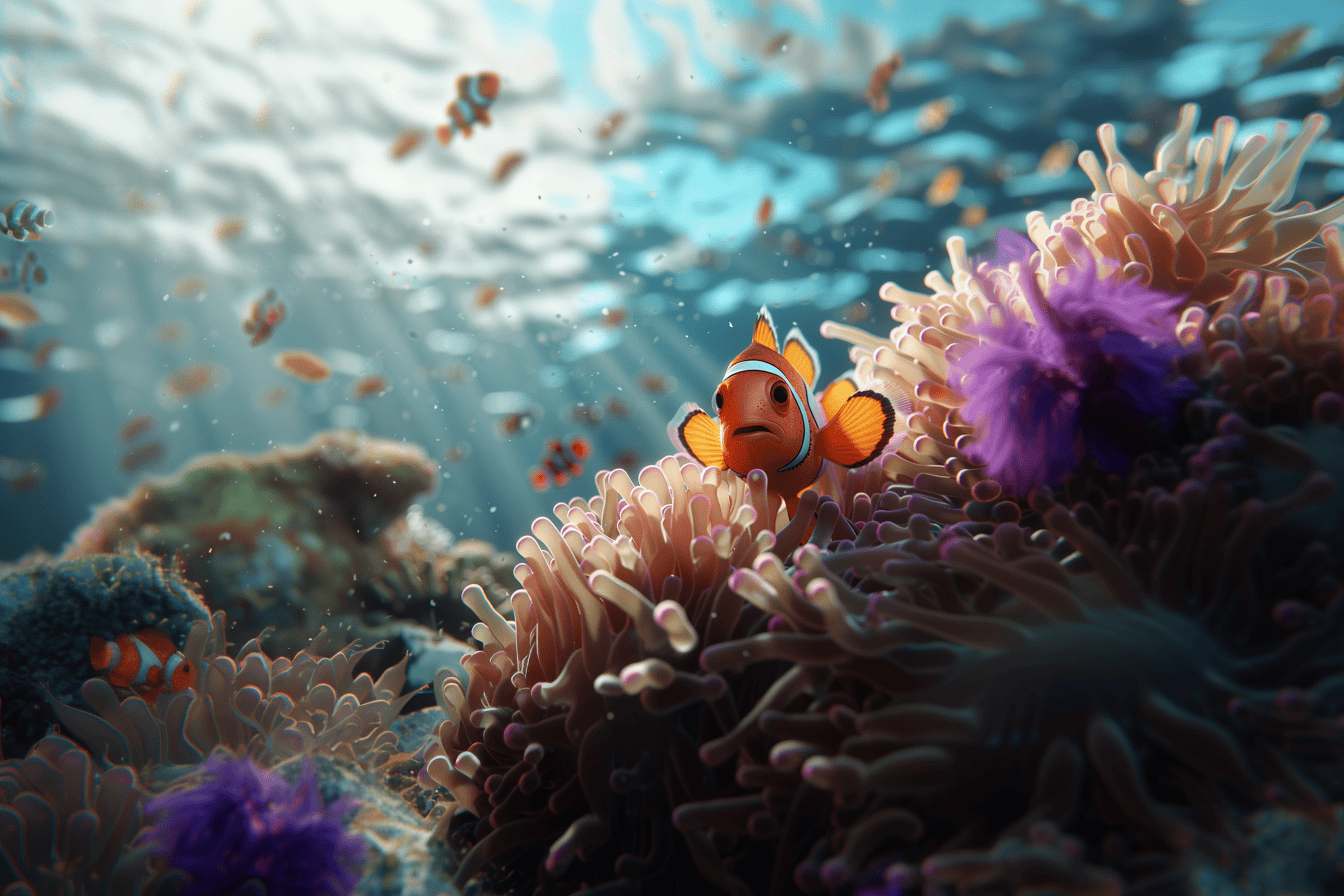
Clownfish have developed several unique adaptations that allow them to thrive in their symbiotic relationship with sea anemones. One key adaptation is the special mucus that covers their bodies. This mucus protects clownfish from the anemone’s stinging cells, called nematocysts, which would otherwise be deadly to other fish.
Because of this protective layer, clownfish can swim among the tentacles of sea anemones without getting harmed.
In this mutualism, both clownfish and sea anemones benefit greatly. Clownfish gain protection from predators by hiding within the anemone’s stinging tentacles. Predators that might consider a clownfish for a meal are deterred by the anemone’s potent defenses.
Furthermore, clownfish are known to be territorial and will chase away intruders, providing the anemone with a vigilant guard.
Another fascinating adaptation is the bright coloration of clownfish. Their vivid orange and white stripes can serve as a warning to potential predators about the dangers of approaching a sea anemone.
Sea Anemone Characteristics
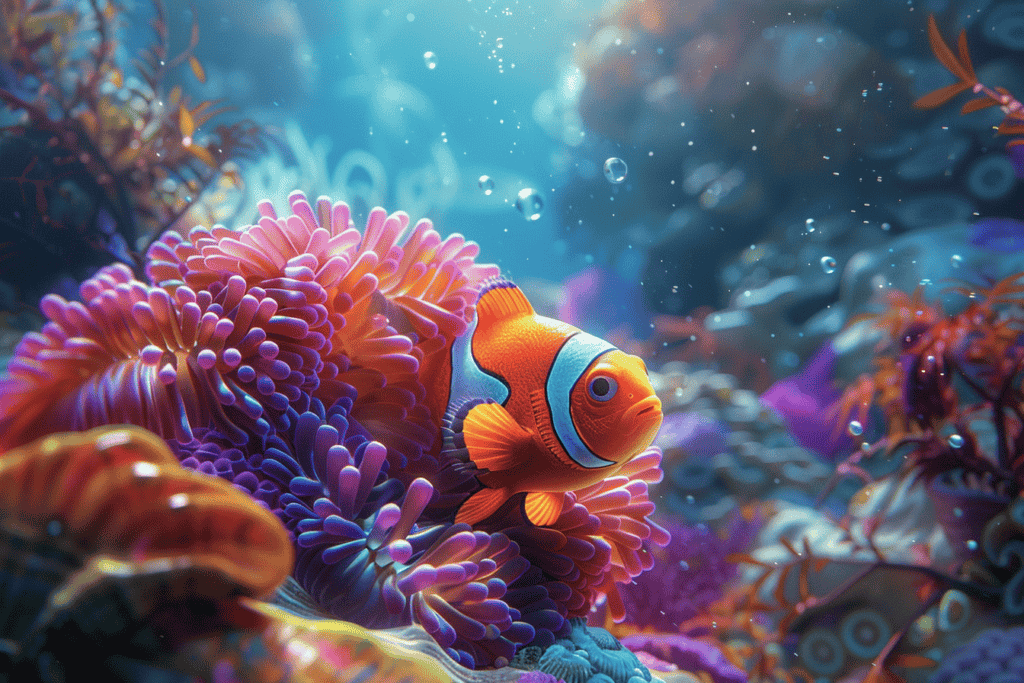
Sea anemones, known for their vibrant colors and stinging tentacles, possess several unique characteristics that make them fascinating marine creatures.
Living mainly on coral reefs, these anemones form essential parts of the underwater ecosystem.
Their tentacles, often swaying gently in the water, aren’t just for show. They harbor a potent poison that serves as a defense mechanism and a means to capture prey. When an unsuspecting fish brushes against them, the anemone’s toxin is released, paralyzing the prey almost instantly.
The anemones’ tentacles are equipped with specialized cells called nematocysts, which contain this powerful toxin. This characteristic allows anemones to thrive in the competitive environment of coral reefs. Notably, the potency of their poison varies among the different species, but all anemones benefit from this trait, ensuring their survival and continued dominance in their habitats.
These marine creatures also exhibit a remarkable ability to regenerate damaged parts, making them resilient and adaptable.
Their symbiotic relationships with other species, like clownfish, further highlight their role in the marine ecosystem.
Nutrient Exchange
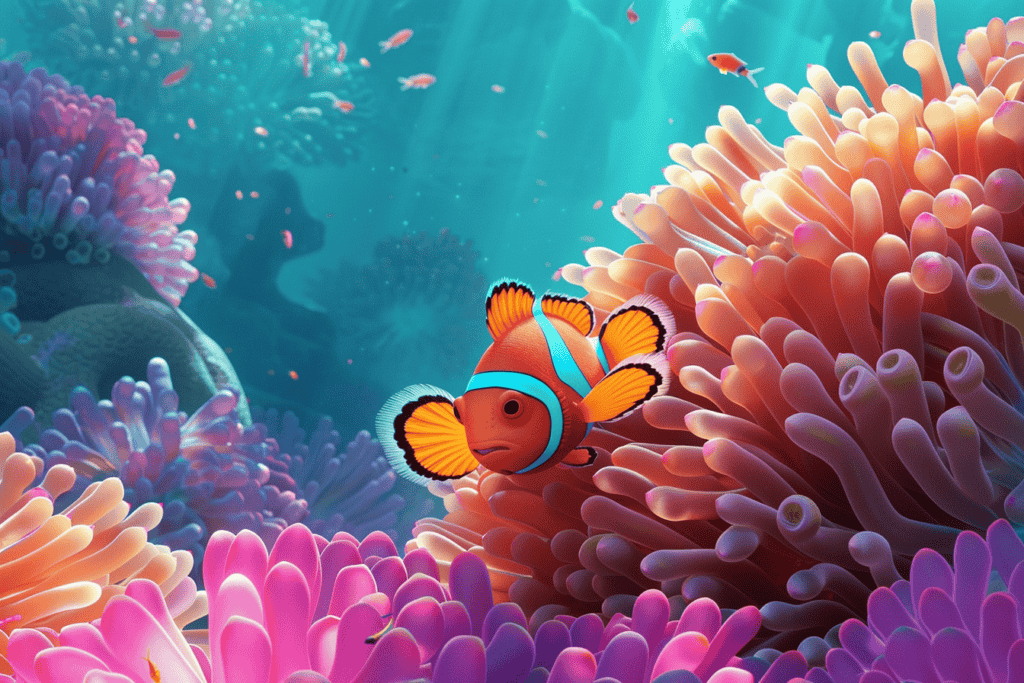
You might be surprised to learn that clownfish provide essential nutrients to their sea anemone hosts through their waste.
This intriguing process is a cornerstone of their mutualistic partnership, benefiting both species in remarkable ways. The waste produced by clownfish is a rich source of nitrogen, a key nutrient that sea anemones need to maintain their health and well-being.
When clownfish release their waste, it acts as a natural fertilizer for the anemones.
This nutrient exchange allows the anemones to grow and thrive in their underwater environment, ensuring they remain vigorous and resilient. In this partnership, the anemones receive a steady supply of nutrients, which helps them sustain their energy levels and overall vitality.
The mutualism between clownfish and sea anemones is truly fascinating.
This nutrient exchange isn’t just a one-sided benefit; it’s a critical component that supports the survival of both species. Clownfish find a safe haven among the anemone’s stinging tentacles, while the anemones gain essential nutrients to flourish.
This symbiotic relationship exemplifies the intricate and interconnected nature of life under the sea, showcasing how cooperation can lead to mutual prosperity.
Ecological Impact

Clownfish and sea anemones contribute substantially to the biodiversity and stability of coral reef ecosystems. Their mutualism is a prime example of how a symbiotic partnership can have a profound ecological impact.
When clownfish live among the tentacles of sea anemones, they don’t just find shelter; they also provide nutrients to their hosts. These nutrients come from the clownfish’s waste, which helps the sea anemone grow and thrive.
In turn, the sea anemone offers protection to the clownfish, keeping predators at bay with its stinging cells. This relationship guarantees that both species not only survive but flourish, promoting a healthy and diverse reef environment.
The presence of these partnerships attracts other marine life, enhancing the overall complexity and resilience of the ecosystem.
Behavioral Interactions

Beyond their ecological impact, the behavioral interactions between clownfish and sea anemones reveal a fascinating dynamic that guarantees mutual survival.
The relationship between clownfish and sea anemones is a prime example of mutualism. The sea anemone provides a safe haven where clownfish can make their homes, thanks to its stinging tentacles that deter predators. In return, clownfish protect the sea anemone from parasites and predators, creating a beneficial cycle.
When clownfish and sea anemones first meet, the clownfish perform an intricate dance. They gently touch the tentacles with various parts of their bodies, slowly building up immunity to the sting. This careful acclimatization allows them to live harmoniously within the anemone’s protective embrace.
Clownfish are also known for their bold behavior. They venture out to lure potential threats away from the anemone, effectively acting as a living shield. Furthermore, the waste produced by clownfish serves as a nutrient source for the sea anemone, enhancing its growth and health.
This dynamic interaction showcases how both species adapt and collaborate, ensuring their mutual survival in the challenging underwater environment. Their partnership isn’t just a necessity but a well-choreographed dance of mutual benefit.
Frequently Asked Questions
How Do Clownfish Communicate With Each Other?
You’ll notice clownfish communicate using sound patterns, body language, and visual signals. They establish social hierarchy and express mating behaviors with chemical cues and synchronized movements, ensuring effective interaction and cohesion within their groups.
What Are the Common Predators of Clownfish?
When you consider the common predators of clownfish, think about their natural enemies like larger fish, eels, and sharks. These predators exhibit specific feeding habits and predator behavior, posing significant predatory threats and habitat dangers.
What Types of Sea Anemones Host Clownfish?
You’re wondering about anemones that host clownfish. Clownfish choose anemone species based on host preferences, anemone selection, and habitat compatibility. This mutualistic relationship provides symbiotic benefits, offering clownfish protection while the anemones gain nourishment.
How Long Can Clownfish Live in the Wild?
Clownfish can live up to 6-10 years in the wild, depending on diet habits, habitat preferences, and environmental threats. Lifespan variations also stem from their breeding season, growth rate, and how they adapt to changes.
What Is the Role of Clownfish in Popular Culture?
When exploring the role of clownfish in popular culture, you’ll notice their film representation and cultural symbolism. They’re big in children’s media, drive aquarium popularity, inspire merchandise appeal, and serve as character inspiration in various stories.

